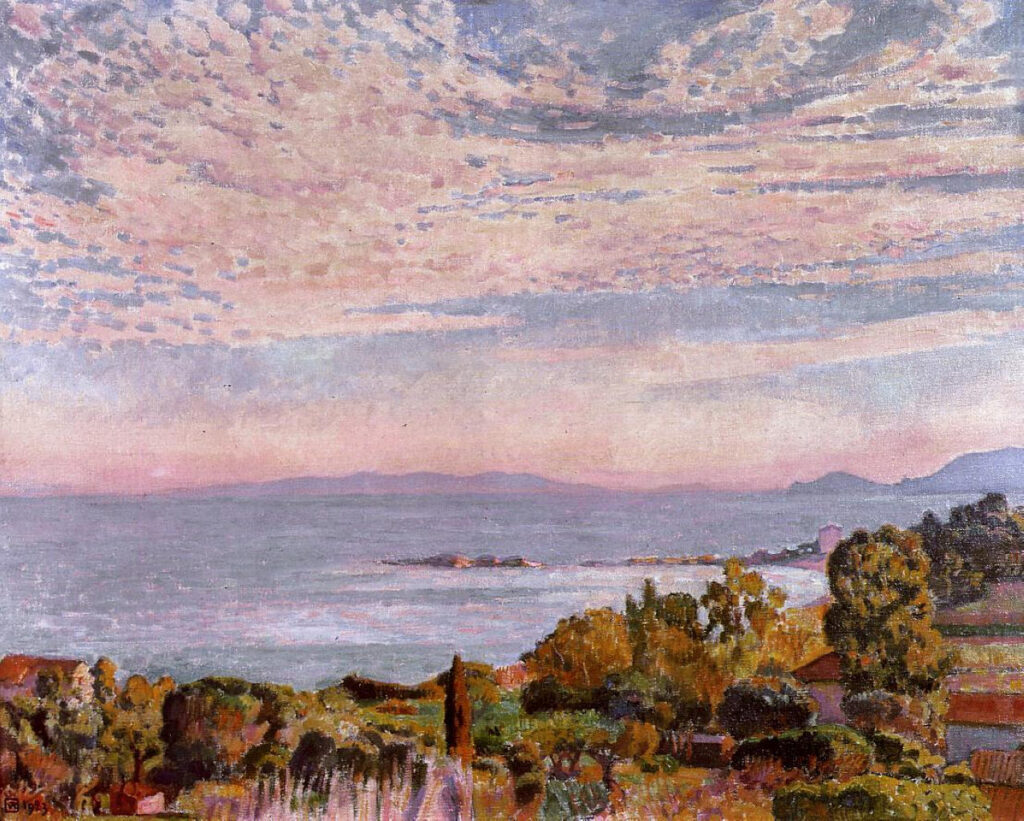Paintings of 1923: 3 Landscapes

In this, the third compilation of paintings believed to have been made a century ago, in 1923, I show the first of two collections of landscape paintings. Those below show views of France, and those in the next and concluding article show the rest of Europe and further afield.
We start on the island of Groix, in Brittany, at the northern end of the Bay of Biscay, and conveniently close to the renowned artists’ colony at Le Pouldu.
Paul Signac (1863-1935), Blessing of the Tuna Fleet at Groix (Cachin 562) (December 1923), oil on canvas, 73.7 x 92.7 cm, Minneapolis Institute of Art, Minneapolis, MN. Wikimedia Commons.
Paul Signac visited Groix several times to witness and sketch the annual blessing of its fishing fleet. In December 1923, he painted this finished oil version of the Blessing of the Tuna Fleet at Groix, which was exhibited the following year at the Salon des Indépendants, where it attracted high praise.
Pierre Bonnard (1867-1947), The Seine at Vernon (c 1923), oil on canvas, 35.5 x 76.2 cm, Private collection. The Athenaeum.
At this time, Pierre Bonnard still had a country house at Vernon, downriver from Paris, and not far from Claude Monet’s property at Giverny. Bonnard painted many splendid landscapes there, including this of The Seine at Vernon. He also returned to his family home in south-eastern France, Le Grand-Lemps, which is at the western edge of the foothills of the Alps.
Pierre Bonnard (1867-1947), In Front of the Window at Le Grand-Lemps (1923), oil on canvas, 65 x 64 cm, Musée des Beaux-Arts de Lyon, Lyon, France. The Athenaeum.
In Front of the Window at Le Grand-Lemps is one of Bonnard’s pictures-within-a-picture using a window and light. Just in front of the window are two women, one of them adjusting her hat, and a young boy, who looks almost ghostly in the bright sunlight.
Félix Vallotton (1865–1925), Broom in Bloom, Avallon (1923), oil on canvas, 72.8 x 54 cm, Private collection. Wikimedia Commons.
Félix Vallotton’s Broom in Bloom, Avallon shows an idyllic scene of fishing beside the river near the appropriately-named Avallon, which is south-east of Paris, towards Dijon and the Alps.
Lesser Ury (1861–1931), Boulevard in Paris (1923), oil on canvas, 9 x 15.8 cm, Private collection. Wikimedia Commons.
The German painter Lesser Ury made this small oil sketch of a Boulevard in Paris during one of his visits to France, with its gestural depiction of motor taxis.
Paul Signac (1863-1935), Rodez (c 1923), black chalk and watercolour, 22 x 23.5 cm, Albertina, Vienna, Austria. Wikimedia Commons.
Paul Signac should have been busy painting the rivers of France, but instead chose the town of Rodez, which isn’t far from Montauban in Occitania, but lacks a significant river.
Many of the more avant garde artists were gathering in the south of France, among them Théo van Rysselberghe, Paul Signac and of course Pierre Bonnard.
Théo van Rysselberghe (1862–1926), la Baie de St Clair (The Bay of St Clair) (1923), oil on canvas, 91.4 x 73.6 cm, Private collection. WikiArt.
Van Rysselberghe’s The Bay of St Clair shows this classic view of the Mediterranean coast near Le Lavandou.
Paul Signac (1863-1935), Saint-Tropez, the Pier (21 December 1923), black pen and watercolour on paper, 21 x 19 cm, location not known. Wikimedia Commons.
Paul Signac painted this view of boats at low tide alongside Saint-Tropez, the Pier on 21 December 1923. Even during Spring tides, the tidal range at Saint-Tropez is little more than 30 cm (1 foot), suggesting these boats have been deliberately beached alongside the pier.
Pierre Bonnard (1867-1947), The Riviera (c 1923), oil on canvas, 79 x 76.2 cm, The Phillips Collection, Washington, DC. The Athenaeum.
Bonnard’s The Riviera from about 1923 shows le Midi in the brilliant white light of the middle of the day, with much of its colour burnt out by dazzle.


